I got a standing ovation this week. First ever. I forgot to say thank-you. I just watched, stunned: in relief that the talk was over. The whole room of some 50 people stood up in spontaneous applause. This was a group of courageous folks involved in recovery from addictions and I was asked to speak to them about the meaning in my work and how I came to it. It was clear to me that their thanks was for the One who was really shining through, and that was my prayer. It was so sweet! And, I sold every one of my books that I brought along that night.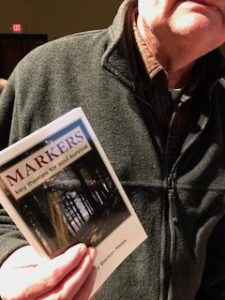
The emphasis I’d planned was how my own life was changed by the same God who can change them. I am used to more hardened audiences. I prepare for skeptics and others who “have to be there” like the kid in a University class last month who asked in the Q&A “how old ARE you?”
But this group of hurting folks was the most loving and alert large group I’ve ever encountered. I heard a verse from a song by Chris Rice this morning that summarized the experience “Raise your head for love is passing by”. That’s the way I felt when with these earnest recover-ers. They are raising their heads, and with them we all got to see Love in the room.
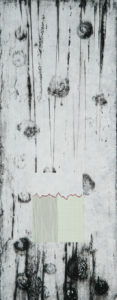 I showed them some pieces like this one, “Time and Mercy” where the chaos is falling down all around the inner life. But there on the inside is the mark of a heartbeat, and the recording of time. There’s a history that is undeniable, part of the fabric that cannot be changed. There’s a span ahead yet unknown. But in this present moment I can breathe and pause. This is the potential moment where beauty is born. For right now I can lift my head because the evidence of love is still shining through for those who are eager for it.
I showed them some pieces like this one, “Time and Mercy” where the chaos is falling down all around the inner life. But there on the inside is the mark of a heartbeat, and the recording of time. There’s a history that is undeniable, part of the fabric that cannot be changed. There’s a span ahead yet unknown. But in this present moment I can breathe and pause. This is the potential moment where beauty is born. For right now I can lift my head because the evidence of love is still shining through for those who are eager for it.
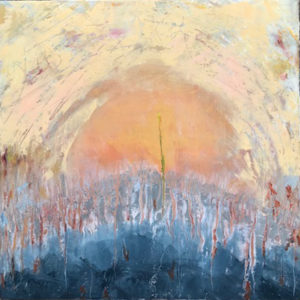 The theme keeps repeating and it’s a universal one. From mythology to classic literature this idea of trekking toward some kind of attainment is in our DNA. Moses, Odysseus, Buddha, Lao Tzu, Dante — the list is long of courageous ones who were answering the ancient quest “where have you come from, and where are you going?”* Something keeps us moving, sometimes for what we’re not even sure; and if our bodies get tired, our spirits keep longing.
The theme keeps repeating and it’s a universal one. From mythology to classic literature this idea of trekking toward some kind of attainment is in our DNA. Moses, Odysseus, Buddha, Lao Tzu, Dante — the list is long of courageous ones who were answering the ancient quest “where have you come from, and where are you going?”* Something keeps us moving, sometimes for what we’re not even sure; and if our bodies get tired, our spirits keep longing.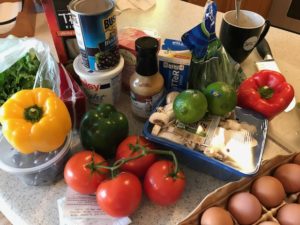 I slammed my computer closed this morning. The click-bait headlines have me so wearied, sickened. You can point fingers, but we’re all in this thing together. So, I did the next thing in my little life. I went to the grocery store. I had to do this anyway today, but I got there early and started to relish the simple tasks of handling and selecting real live things that will make a difference in our well being this week. I got to choose. I chose to enjoy the steps, the colors, the kindness of the produce man. I don’t think I have ever enjoyed a grocery trip more! I came home with several bags of supplies, and arranged some on my counter like a Dutch still life. Art is not imitating life here. Real life was already happening. You could rather say Life is imitating art of a sort. This is some of the gleanings I’ll use up this week.
I slammed my computer closed this morning. The click-bait headlines have me so wearied, sickened. You can point fingers, but we’re all in this thing together. So, I did the next thing in my little life. I went to the grocery store. I had to do this anyway today, but I got there early and started to relish the simple tasks of handling and selecting real live things that will make a difference in our well being this week. I got to choose. I chose to enjoy the steps, the colors, the kindness of the produce man. I don’t think I have ever enjoyed a grocery trip more! I came home with several bags of supplies, and arranged some on my counter like a Dutch still life. Art is not imitating life here. Real life was already happening. You could rather say Life is imitating art of a sort. This is some of the gleanings I’ll use up this week.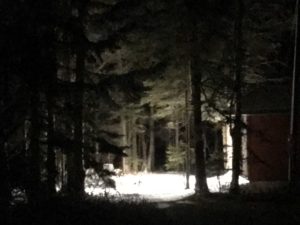 The last image of the year is one my husband shot out our tiny cabin window. The garage light was on, and all was still on the darkest night of the year in the Northland where my grandparents settled long ago. The frigid air, the wild vunerability of this backwater place and the mystery of light penetrating, so surgically into enveloping darkness was what moved us both with this digital glimpse. This is only a token, an illustration, of a sublime reality. I’m thinking of a baby born on another dark night, in another backwater place, where light burst forth into their precarious situation. John’s gospel says at the beginning “light shines (present tense) into the darkness, and the darkness did not comprehend it.” John 1:5
The last image of the year is one my husband shot out our tiny cabin window. The garage light was on, and all was still on the darkest night of the year in the Northland where my grandparents settled long ago. The frigid air, the wild vunerability of this backwater place and the mystery of light penetrating, so surgically into enveloping darkness was what moved us both with this digital glimpse. This is only a token, an illustration, of a sublime reality. I’m thinking of a baby born on another dark night, in another backwater place, where light burst forth into their precarious situation. John’s gospel says at the beginning “light shines (present tense) into the darkness, and the darkness did not comprehend it.” John 1:5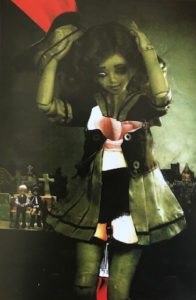 But then, I noticed a diminutive collage, chosen as a favorite by the museum staff, “Art to Stop Traffic: What Mercy Requires of Us”. The piece is only 5”x 3.5”. This submission is a poignant contrast, rendered from found images, paper, pen and pencil. The value and color contrast is immediately obvious, but peering closer one sees the uncomfortable juxtaposition of plastic expressions, skin color, garish lighting, things hidden and things exposed.
But then, I noticed a diminutive collage, chosen as a favorite by the museum staff, “Art to Stop Traffic: What Mercy Requires of Us”. The piece is only 5”x 3.5”. This submission is a poignant contrast, rendered from found images, paper, pen and pencil. The value and color contrast is immediately obvious, but peering closer one sees the uncomfortable juxtaposition of plastic expressions, skin color, garish lighting, things hidden and things exposed.
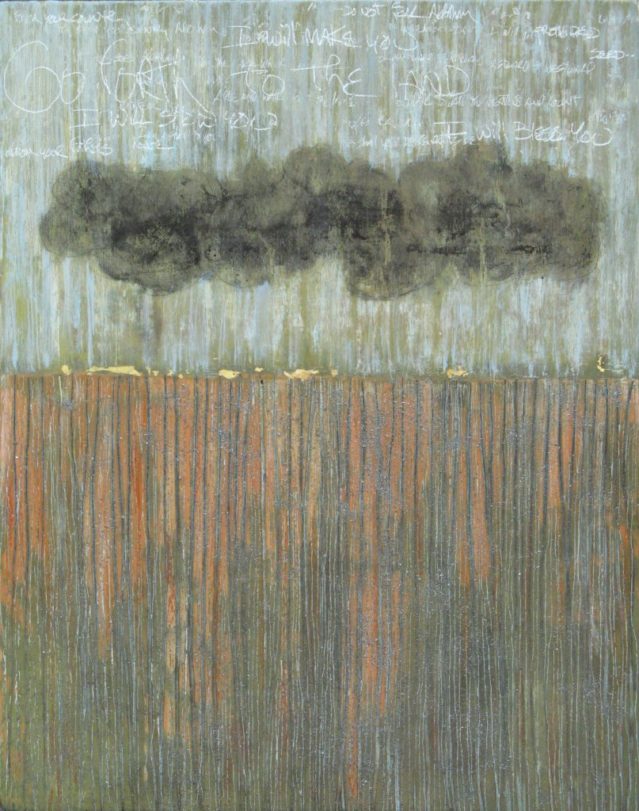
 I don’t think it is a very pretty piece, and therefore, to me, all the more true.
I don’t think it is a very pretty piece, and therefore, to me, all the more true. This piece startled me. Unmistakably Chagall, unmistakably modern, while being uncharacteristically direct as a narrative. I was already thinking about targets, about careful communication with the viewer (see last post). And then this. Chagall nails it. And he wants to make sure you can see it too.
This piece startled me. Unmistakably Chagall, unmistakably modern, while being uncharacteristically direct as a narrative. I was already thinking about targets, about careful communication with the viewer (see last post). And then this. Chagall nails it. And he wants to make sure you can see it too.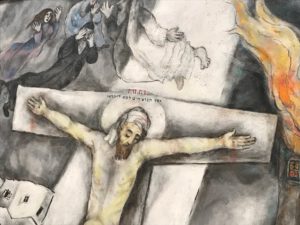
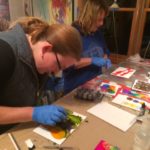
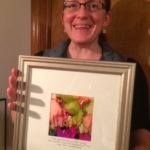 Voila, or “There it is!” was the result after a couple hours of experimentation. We really are creative whether we understand how we’re made or not. The excitement in getting a glimpse of that is contagious. This finished result was just one of several little gems made that night. Liz illuminated a favorite quote from Brenda Ueland’s “If You Want to Write”: “Since you are like no other being ever created since the beginning of time, you are incomparable.”
Voila, or “There it is!” was the result after a couple hours of experimentation. We really are creative whether we understand how we’re made or not. The excitement in getting a glimpse of that is contagious. This finished result was just one of several little gems made that night. Liz illuminated a favorite quote from Brenda Ueland’s “If You Want to Write”: “Since you are like no other being ever created since the beginning of time, you are incomparable.”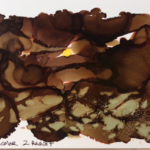
 I am inserting here two little experiments with some inks for a workshop I’ll be conducting next week. Beginners will be introduced to some of the rationale behind abstraction’s promise. If some good work shows up from some of these craftsmen, I’ll be sure to post.
I am inserting here two little experiments with some inks for a workshop I’ll be conducting next week. Beginners will be introduced to some of the rationale behind abstraction’s promise. If some good work shows up from some of these craftsmen, I’ll be sure to post.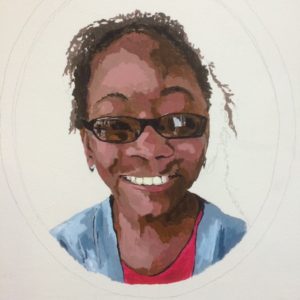 I’m getting some expert help on the mural project we are spearheading for a local non-profit. But this face I reserved to do myself. This little girl is precious, with big ideas, so she is being placed on one of the most important parts of the wall. I love her funky glasses. I love most the reflection out from her eyes and even off the plastic lenses. That was really, really fun to paint!
I’m getting some expert help on the mural project we are spearheading for a local non-profit. But this face I reserved to do myself. This little girl is precious, with big ideas, so she is being placed on one of the most important parts of the wall. I love her funky glasses. I love most the reflection out from her eyes and even off the plastic lenses. That was really, really fun to paint!